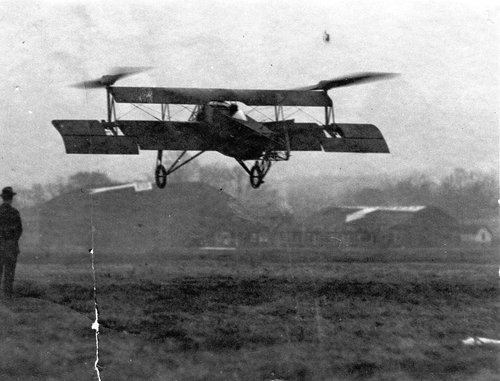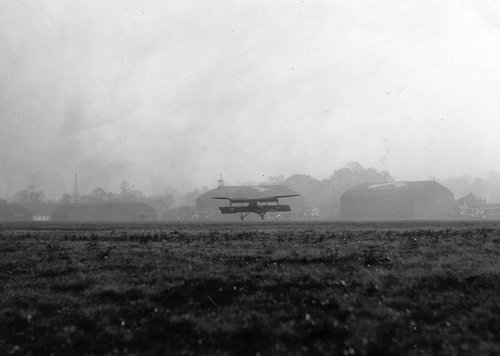- Joined
- 25 June 2009
- Messages
- 14,669
- Reaction score
- 5,848
If you ask anyone with even the slightest knowledge of aviation history who invented the first American helicopter, they usually speak of Igor Sikorsky. While it is true that Sikorsky produced the first practical helicopter in 1939—resulting in the very first military order ever for a rotary wing aircraft as the R-4—Sikorsky was by no means the first American to build and successfully fly a helicopter.
Even when Sikorsky was still only a youngster in imperial Russia, he was already fascinated with rotary wings, and designed in 1908 and 1909 his first helicopters, the HJS-1 and HJS-2. At the very same time, an American by the name of Emile Berliner (who had already created the grammophone and the flat-disc records that replaced Thomas Edison’s cylindrical records) was now busy working on what was to become the first American helicopter. Berliner began by designing what may well be the first production rotary aircraft engine, the 36 hp Adams-Farwell engine. In 1908, John Newton Williams constructed a coaxial machine for Berliner using two of these rotary engines. It reportedly lifted both Williams and the machine – a total of 277 kg – but three feet off the ground; and though it was probably steadied, this was undoubtedly the first ever U.S. manned helicopter flight.
In May, 1908, Williams built another stand in Hammondsport, New York, as a member of the famed Aerial Experiment Association (which included Alexander Bell and Glenn Curtiss), using a 40 hp Curtiss engine. It made hovers around 1m, again steadied from the ground. Despite this semi-failure, Emile Berliner never gave up on his idea. He went on to build several other helicopters, and also suggested the use of an auxiliary tail rotor — a standard feature of helicopters today — to stabilize flight.
After Berliner suffered a nervous breakdown in 1914, it was his son, Henry, who took over the exploration of vertical flight machines. In June 1919, Henry Berliner built a machine with two co-axial propellers with vanes to vector the downwash for pitch control. Stabilizing the helicopter in flight was still a problem, though, and hovering flights again had to be steadied. Yet in 1920 the machine managed to move forward several yards, representing the first manned, controlled helicopter flight — or maybe jump — in the United States.
Three years later the Berliners built a new helicopter prototype by using the fuselage of a Nieuport 23 biplane with a 4.5m (14-ft.) rotor mounted on an outrigger on either side of and slightly forward of the cockpit. Control vanes, similar to those used on their 1919 coaxial machine, were used in the slipstream. Longitudinal control was by a small variable pitch lifting propeller near the tail. The pilot could tilt the main rotors to control yaw. Opening and closing louvers underneath the rotors controlled roll. A Bentley 220-horsepower engine was connected to geared shafts that turned the wingtip rotors in opposite directions. Henry’s historic June 1922 demonstration flight took place at College Park, Maryland, near Washington, D.C. The Berliner helicopter flew about 90m, and hovering up to 3.3m was accomplished. Overall performance was rather unsatisfactory, yet the Smithsonian Institute considers the Berliner machine as the first helicopter to make a controlled flight on the basis of these tests, despite a dispute by those who credit the Engineering Division’s de Bothezat helicopter free-flight on October 19, 1922.
The Berliners continued their efforts, bringing further refinements to their hybrid design, and built two additional machines, but they were short take-off convertaplanes. The Model No. 5 craft was demonstrated in front of Navy officials and the press on Feb. 24, 1924. It could move at about 40 mph, rise to an altitude of 15 feet and turn with a radius of 150 feet.
Here is an text about that machine taken from An Introduction to the Helicopter, published by NACA in 1925:
Berliner photos on the web:
http://www.old-picture.com/american-history-1900-1930s/Helicopter-Berliner.htm
http://cf.alpa.org/internet/alp/2000/aug00p28.htm
http://www.usaf.com/museums/college_park_aviation_museum.htm
http://www.uen.org/utahlink/tours/tourElement.cgi?element_id=25907&tour_id=14628&category_id=21854
http://www.wired.com/images_blogs/thisdayintech/2010/06/18_berliner_1924.jpg
Main sources for this article:
- June 16, 1922: Ich Bin ein Berliner Helicopter By Robert Lemos
- An introduction to the Helicopter by Alexander Klemin
- The Aviastar website
Even when Sikorsky was still only a youngster in imperial Russia, he was already fascinated with rotary wings, and designed in 1908 and 1909 his first helicopters, the HJS-1 and HJS-2. At the very same time, an American by the name of Emile Berliner (who had already created the grammophone and the flat-disc records that replaced Thomas Edison’s cylindrical records) was now busy working on what was to become the first American helicopter. Berliner began by designing what may well be the first production rotary aircraft engine, the 36 hp Adams-Farwell engine. In 1908, John Newton Williams constructed a coaxial machine for Berliner using two of these rotary engines. It reportedly lifted both Williams and the machine – a total of 277 kg – but three feet off the ground; and though it was probably steadied, this was undoubtedly the first ever U.S. manned helicopter flight.
In May, 1908, Williams built another stand in Hammondsport, New York, as a member of the famed Aerial Experiment Association (which included Alexander Bell and Glenn Curtiss), using a 40 hp Curtiss engine. It made hovers around 1m, again steadied from the ground. Despite this semi-failure, Emile Berliner never gave up on his idea. He went on to build several other helicopters, and also suggested the use of an auxiliary tail rotor — a standard feature of helicopters today — to stabilize flight.
After Berliner suffered a nervous breakdown in 1914, it was his son, Henry, who took over the exploration of vertical flight machines. In June 1919, Henry Berliner built a machine with two co-axial propellers with vanes to vector the downwash for pitch control. Stabilizing the helicopter in flight was still a problem, though, and hovering flights again had to be steadied. Yet in 1920 the machine managed to move forward several yards, representing the first manned, controlled helicopter flight — or maybe jump — in the United States.
Three years later the Berliners built a new helicopter prototype by using the fuselage of a Nieuport 23 biplane with a 4.5m (14-ft.) rotor mounted on an outrigger on either side of and slightly forward of the cockpit. Control vanes, similar to those used on their 1919 coaxial machine, were used in the slipstream. Longitudinal control was by a small variable pitch lifting propeller near the tail. The pilot could tilt the main rotors to control yaw. Opening and closing louvers underneath the rotors controlled roll. A Bentley 220-horsepower engine was connected to geared shafts that turned the wingtip rotors in opposite directions. Henry’s historic June 1922 demonstration flight took place at College Park, Maryland, near Washington, D.C. The Berliner helicopter flew about 90m, and hovering up to 3.3m was accomplished. Overall performance was rather unsatisfactory, yet the Smithsonian Institute considers the Berliner machine as the first helicopter to make a controlled flight on the basis of these tests, despite a dispute by those who credit the Engineering Division’s de Bothezat helicopter free-flight on October 19, 1922.
The Berliners continued their efforts, bringing further refinements to their hybrid design, and built two additional machines, but they were short take-off convertaplanes. The Model No. 5 craft was demonstrated in front of Navy officials and the press on Feb. 24, 1924. It could move at about 40 mph, rise to an altitude of 15 feet and turn with a radius of 150 feet.
Here is an text about that machine taken from An Introduction to the Helicopter, published by NACA in 1925:
An early form of the Berliner helicopter was described in Mechanical Engineering for September, 1922. It was of the simplest possible form, with a 200 HP engine driving two moderate-sized lifting airscrews on either side of the fuselage. Lateral control was secured by the use of three movable fins under each of the propellers; and longitudinal control by a small variable-pitch propeller at the rear of the fuselage. A horizontal stabilizer and elevators and rudder identical with those of an airplane were provided. Successful short flights were achieved.
Quite obviously, Berliner was not satisfied with the safety of his craft in case of engine failure; and in his next design sought to provide the ability to glide by embodying wing surfaces in the structure. It now became a helicopter-airplane. Outline drawings and photographs of this machine are shown in Fig. 9.*
The Berliner helicopter is now provided with a conventionally trussed triplane wing surface and two lifting propellers, which latter also provide forward thrust on inclination of the entire craft. The transmission system is carefully enclosed within the wing surfaces and the interplane struts.
The system of control is complete. As light warping of the wings can be produced by a special control, whereby the axis of the lifting propellers can be inclined at different angles to the line of flight on either side of the machine; so that a turning couple can be obtained. With the lifting propellers in motion, the pilot regulates a variable-pitch propeller placed at the tail end of the machine, so as to raise the tail from the ground. Under the action of the lifting propeller the helicopter leaves the ground. The rear propeller permits the further inclination of the axis of the lifting propeller until a forward component of the thrust is obtained, with resulting forward speed. Lateral equilibrium is maintained by a system of movable fins placed below tho disk area of the propellers. It can be seen that the system of control is fully operative whether in forward flight or hovering flight or vertical movement.
If the lifting propellers become inoperative, either owing to damage or engine failure, the machine becomes a glider. On the glide, wind-tunnel experiments seem to indicate a best L/D of only 4. On the glide, warping of the wings takes care of lateral control; an ordinary rudder and elevator act in the usual manner.
The gross weight of the machine with pilot and fuel for a twenty-minute flight is about 1950 lb. The engine is a Bentley Rotary Model 2, air-cooled, providing 220 HP. at 1200 R.P.M. The lifting propellers turn at about 560 R.P.M. and have a diameter of 15 ft. The span of the wings is 39 ft. and the chord is approximately 1 ft. 11 in. The overall length is 20 ft . 6 in. and overall height about 6 ft. 8 in.
According to reports of the Italian Air Attaché in Washington, the machines makes only a fair getaway. The maneuverability seems satisfactory, and the aircraft responds well to the controls. In a moderate but irregular wind the oscillations appeared important. The Berliner helicopter is still in an experimental form, but it has definitely achieved vertical flight, and complete freedom of evolution. Its ability to glide is an important factor as regards safety. The maximum duration of flight achieved so far appears to be 1 min. 35 sec., and the highest altitude reached, 15 ft.
* Notizario di Aeronautica, No. 5, May, 1924. Elicotero Berliner Modificato.
Berliner photos on the web:
http://www.old-picture.com/american-history-1900-1930s/Helicopter-Berliner.htm
http://cf.alpa.org/internet/alp/2000/aug00p28.htm
http://www.usaf.com/museums/college_park_aviation_museum.htm
http://www.uen.org/utahlink/tours/tourElement.cgi?element_id=25907&tour_id=14628&category_id=21854
http://www.wired.com/images_blogs/thisdayintech/2010/06/18_berliner_1924.jpg
Main sources for this article:
- June 16, 1922: Ich Bin ein Berliner Helicopter By Robert Lemos
- An introduction to the Helicopter by Alexander Klemin
- The Aviastar website
Attachments
-
 Helicopter-Berliner.jpg52.7 KB · Views: 332
Helicopter-Berliner.jpg52.7 KB · Views: 332 -
 berliner.gif10.9 KB · Views: 69
berliner.gif10.9 KB · Views: 69 -
 Berliner helicopter.gif161.1 KB · Views: 74
Berliner helicopter.gif161.1 KB · Views: 74 -
 berliner_4.jpg44.7 KB · Views: 63
berliner_4.jpg44.7 KB · Views: 63 -
 berliner_3.jpg24.9 KB · Views: 278
berliner_3.jpg24.9 KB · Views: 278 -
 berliner_2.jpg28.8 KB · Views: 292
berliner_2.jpg28.8 KB · Views: 292 -
 berliner_1.jpg29.7 KB · Views: 301
berliner_1.jpg29.7 KB · Views: 301 -
 18_berliner_1924.jpg74.5 KB · Views: 309
18_berliner_1924.jpg74.5 KB · Views: 309

















